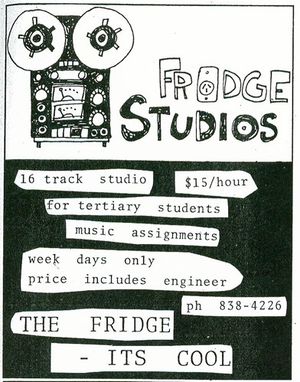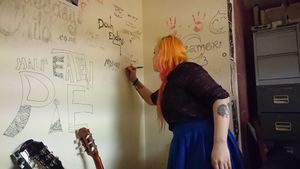Difference between revisions of "The Fridge Studio"
Thedugganaut (Talk | contribs) m |
Thedugganaut (Talk | contribs) m |
||
| (32 intermediate revisions by 4 users not shown) | |||
| Line 1: | Line 1: | ||
| − | [[image:Fridgestudios.jpg|right|thumb|Fridge Studios advertisment. Designed by Bryce Galloway of Wendyhouse and Hitlers | + | [[image:Fridgestudios.jpg|right|thumb|Fridge Studios advertisment. Designed by Bryce Galloway of Wendyhouse and Hitlers Kock]] |
| − | The Fridge was [[Contact 89FM]]'s recording studio, | + | The Fridge was [[Contact 89FM]]'s recording studio. Established in 1987, the need for a dedicated production studio was an idea first initiated by Contact 89FM founder [[Max Christoffersen]]. |
| − | + | The original Cowshed space that would later become The Fridge, was used by the campus photography club. It became Contact 89FM Offices in 1986 after Christoffersen successfully lobbied the WSU for the space to be removed from the very occasional use by club members and dedicated to Contact's expansion plans. | |
| + | |||
| + | During Contact 89FM's first year on air, the station's Cowshed studio doubled as a production studio during the four hour downtime in the middle of weekdays. | ||
| + | |||
| + | Producer John Pattenden would use the on air mics and console to record and mix the station IDs, adverts and stings. With plans to go full-time in 1987, the need for a dedicated production studio space became crucial to any attempt to go on air all day. | ||
| + | |||
| + | Christoffersen's successful lobbying for the extra Cowshed space, lead to the establishment of Contact's offices. Plans were then developed for a production studio due to the extra Cowshed space now available to the station. | ||
| + | |||
| + | The increasing floor space in the Cowshed that was now dedicated to Contact-FM did not go unnoticed at the NEXUS offices next door. In the NEXUS End of Year Awards 1986, Contact was given the 'Brierley's Award for Sudden Success and Expansion', a tongue in cheek award picked up by Waikato Times reporter John Drinnan in his story about Contact's first year on FM. The Times story also noted the plans for the production studio to come the following year. | ||
| + | |||
| + | Serious planning for the PD studio was done towards the end of 1986 and in 1987 [[John Pattenden]] built The Fridge allowing Contact-89FM to go full time on air under the management of [[Glen Cooper]]. | ||
| + | |||
| + | Pattenden was Contact's first production manager and was the first producer to record bands using the multi-channel desk in The Fridge. Among the first recordings produced at The Fridge that year (1987) was Paul Martin's debut album Nightfall. Other local bands Pattenden recorded in the Fridge in 1987, included the [[Chanting Boys]], Russian Caravan and the [[Bio-Luvals]]. | ||
| + | |||
| + | The Fridge's multi-channel desk (Soundtracs 16-8-16) was later stolen from the studio and recovered. | ||
| + | |||
| + | The Fridge name came from the original 'industrial' fridge door that remained in use while the photography club used the premises. It remained the main doorway into the production booth following the studio's construction in 1987. | ||
| + | |||
| + | The Fridge has been used by a plethora of bands. Bands to record albums and live-to-airs at the Fridge included [[Grok]], [[Nodrog]], [[Hand of Glory]], [[Big Muffin Serious Band]], [[Dribbly Cat Attraction]], [[The Emersons]], [[Wendyhouse]], [[Bwa da Riddim]] and an incredible number of others. One spectacular night of live non-stop noise was performed entirely by a revolving door of [[PLOP]] musicians, which lasted 12 hours. [[Greg Locke]] often used this studio to record bands as did Dave Whitehead, Scott Newth and Gordon Bassett. The Hamilton compilation CD [[The Fridge]] was entirely recorded in the studio. The desk was 16-track analogue and the room was actually an old industrial fridge, with no windows and complete with big fridge doors. | ||
| + | |||
| + | Although Contact 89FM had long used the booth to record advertisements, The Fridge Studios came into existence only with the arrival of a 16-track recording deck and studio desk from [[Tandys Recording Studio]]. It was at the axis of analogue and digital audio recording. Tandys - a studio just out of Hamilton, which recorded mainly Hamilton rock and where [[Scott Newth]] and [[Dave Whitehead]] (later to be involved with sound design on Lord of the Rings) worked, was decommissioning its 16 track analogue reel to reel and studio desk. Previously, this type of equipment was out of reach for student stations, but Contact 89FM jumped at the chance and purchased the old equipment and drove it to Hamilton where it became the heart of The Fridge. | ||
The Fridge was also offered at an extremely cheap price per hour for local students in an attempt to get students involved and support the then new music department at the University of Waikato. | The Fridge was also offered at an extremely cheap price per hour for local students in an attempt to get students involved and support the then new music department at the University of Waikato. | ||
| Line 22: | Line 42: | ||
==Revival with The Volume Collective== | ==Revival with The Volume Collective== | ||
| − | In 2016, the Fridge was again revived by the | + | [[image:Antimatter.jpeg|right|thumb|Anti Matter leave their mark]] |
| + | In 2016, the Fridge was again revived by the [[Volume Collective]]. On July 1st, the Fridge was opened and like any fridge that hasn't been opened in 2 years, it smelled terrible. This began the restoration and revitalization of the space. | ||
| + | On April 21, 2017, the aptly named [[In The Fridge]] series began. This saw the 'Fridge' go from being a sparsely used practice space to a weekly recording space for musicians to "Jam and Chat." These have then been uploaded to YouTube [http://www.thevolumecollective.com/in-the-fridge/]. The WSU evicted the Volume Collective in 2019, apparently so [[Nexus]] could use the space to record podcasts. | ||
[[category:studios]] | [[category:studios]] | ||
Latest revision as of 10:18, 7 March 2019
The Fridge was Contact 89FM's recording studio. Established in 1987, the need for a dedicated production studio was an idea first initiated by Contact 89FM founder Max Christoffersen.
The original Cowshed space that would later become The Fridge, was used by the campus photography club. It became Contact 89FM Offices in 1986 after Christoffersen successfully lobbied the WSU for the space to be removed from the very occasional use by club members and dedicated to Contact's expansion plans.
During Contact 89FM's first year on air, the station's Cowshed studio doubled as a production studio during the four hour downtime in the middle of weekdays.
Producer John Pattenden would use the on air mics and console to record and mix the station IDs, adverts and stings. With plans to go full-time in 1987, the need for a dedicated production studio space became crucial to any attempt to go on air all day.
Christoffersen's successful lobbying for the extra Cowshed space, lead to the establishment of Contact's offices. Plans were then developed for a production studio due to the extra Cowshed space now available to the station.
The increasing floor space in the Cowshed that was now dedicated to Contact-FM did not go unnoticed at the NEXUS offices next door. In the NEXUS End of Year Awards 1986, Contact was given the 'Brierley's Award for Sudden Success and Expansion', a tongue in cheek award picked up by Waikato Times reporter John Drinnan in his story about Contact's first year on FM. The Times story also noted the plans for the production studio to come the following year.
Serious planning for the PD studio was done towards the end of 1986 and in 1987 John Pattenden built The Fridge allowing Contact-89FM to go full time on air under the management of Glen Cooper.
Pattenden was Contact's first production manager and was the first producer to record bands using the multi-channel desk in The Fridge. Among the first recordings produced at The Fridge that year (1987) was Paul Martin's debut album Nightfall. Other local bands Pattenden recorded in the Fridge in 1987, included the Chanting Boys, Russian Caravan and the Bio-Luvals.
The Fridge's multi-channel desk (Soundtracs 16-8-16) was later stolen from the studio and recovered.
The Fridge name came from the original 'industrial' fridge door that remained in use while the photography club used the premises. It remained the main doorway into the production booth following the studio's construction in 1987.
The Fridge has been used by a plethora of bands. Bands to record albums and live-to-airs at the Fridge included Grok, Nodrog, Hand of Glory, Big Muffin Serious Band, Dribbly Cat Attraction, The Emersons, Wendyhouse, Bwa da Riddim and an incredible number of others. One spectacular night of live non-stop noise was performed entirely by a revolving door of PLOP musicians, which lasted 12 hours. Greg Locke often used this studio to record bands as did Dave Whitehead, Scott Newth and Gordon Bassett. The Hamilton compilation CD The Fridge was entirely recorded in the studio. The desk was 16-track analogue and the room was actually an old industrial fridge, with no windows and complete with big fridge doors.
Although Contact 89FM had long used the booth to record advertisements, The Fridge Studios came into existence only with the arrival of a 16-track recording deck and studio desk from Tandys Recording Studio. It was at the axis of analogue and digital audio recording. Tandys - a studio just out of Hamilton, which recorded mainly Hamilton rock and where Scott Newth and Dave Whitehead (later to be involved with sound design on Lord of the Rings) worked, was decommissioning its 16 track analogue reel to reel and studio desk. Previously, this type of equipment was out of reach for student stations, but Contact 89FM jumped at the chance and purchased the old equipment and drove it to Hamilton where it became the heart of The Fridge.
The Fridge was also offered at an extremely cheap price per hour for local students in an attempt to get students involved and support the then new music department at the University of Waikato.
Revival with Contact 88.1 FM[edit]
The Fridge was revived by Lauren Kerr-Bell, Nick Johnston, Daniel Howard and Daniel Reese for Contact 88.1FM. The studio operated from 2009 to 2014.
- The Prime Numbers - unreleased EP, 2009
- The Shrugs - Behold / Silver Bullet single, 2009
- Dynamo Go - Poor Alfred single, 2010
- Dead Fires - Hinterland single, 2011
- Dick Dynamite and the Doppelgängers - Live at The Fridge, 2011
- Hot Blooded Ripper - Live at The Fridge, 2011
- Penelope The - The Fridge Sessions, 2011
- Devilskin - demos, 2011
- The Shrugs - Costume Drama, 2012
- Sora Shima - You are Surrounded, 2014
- Wizz Kids - The Fridge EP, 2014
Revival with The Volume Collective[edit]
In 2016, the Fridge was again revived by the Volume Collective. On July 1st, the Fridge was opened and like any fridge that hasn't been opened in 2 years, it smelled terrible. This began the restoration and revitalization of the space. On April 21, 2017, the aptly named In The Fridge series began. This saw the 'Fridge' go from being a sparsely used practice space to a weekly recording space for musicians to "Jam and Chat." These have then been uploaded to YouTube [1]. The WSU evicted the Volume Collective in 2019, apparently so Nexus could use the space to record podcasts.

